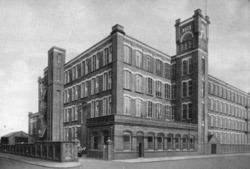Current owners Site of Superstore Main contractor E. & J. Smethurst Year built February 1891 Engine maker George Saxon & Co Year 1892 | Completed August 1893 Architect Sydney Stott of Oldham Demolished 1971 Floor count 4 | |
 | ||
Owner Rock mill Spinning Company Serving railway | ||
Rock Mill was cotton spinning mill in the Waterloo district of Ashton-under-Lyne, Greater Manchester, in England. It was built between 1891 and 1893 for the Ashton Syndicate by Sydney Stott of Oldham. Rock Mill was built on the site of Wilshaw Mill retaining and using the octagonal chimney. It ceased spinning cotton in the 1960s and was demolished in 1971; the site is now an Asda supermarket.
Contents
Location
Rock mill was built on the site of the former Wilshaw Mill, on the junction of Oldham Road and Wilshaw Lane. This had been an unusual site for a mill as it was not close to railways or canals. The water needed to supply the steam engine came from a reservoir formed by damming the Smallshaw Brook. The reservoir was enlarged when the new mill was built
History
The Minerva Spinning Company Limited was registered in 1891 to build the Minerva Mill at Whitelands. The directors were Messrs Barlow, Marland, Coop, Newton, Pollitt and Pownall; they were later referred to as the Ashton syndicate. In April 1891, the syndicate registered the Rock Mill Spinning Company Ltd to build the Rock Mill. It was built with a capital of 60,000 GBP. The syndicate went on to build Atlas Mill, Curzon Mill, Tudor Mill, Cedar Mill and finally the Texas Mill. Construction was slow, it was not completed until August 1893. Even then only a third of its 66,000 spindles were working.
The cotton industry peaked in 1912 when it produced 8 billion yards of cloth. The great war of 1914–1918 halted the supply of raw cotton, and the British government encouraged its colonys to build mills to spin and weave cotton. The war over, Lancashire never regained its markets. In the 1920s Rock Mill joined the Atlas Mills Ltd. group, but the independent mills were struggling. The Bank of England set up the Lancashire Cotton Corporation in 1929 to attempt to rationalise and save the industry. Atlas Mills Limited was taken over by the LCC in 1929. Thus, Rock Mill was one of 104 mills brought into LCC ownership, and one of the 53 mills that survived through to 1950, where it produced 30 and 40 count mule twist. It closed in the 1960s and was used as a warehouse.
It was demolished in 1971 to make way for Ashtons first Asda supermarket.
Architecture
This was a Sydney Stott building. It was four storeys high built on a basement. It was 21 bays long (65m), and 40m wide with a water tower on the long side. The Chimney was octagonal as it also used by the previous mill .
Power
The steam engine was a 1250 hp triple expansion four cylinder by George Saxon & Co, of Openshaw built in 1892. The twin Low pressure cylinders had a diameter of 40in, the intermediate was 36in and the high pressure was 22in. It had a 6 ft stroke. All cylinders had Corliss valves. They drove 16 ft geared flywheel that geared up, 120 teeth onto 54. The air pumps driven by crossheads.
Usage
Rock Mill was used for spinning finer counts of Egyptian cotton, for twists. By 1911 it was spinning both Egyptian and American, and in 1951 it was spinning 30's and 40's.
